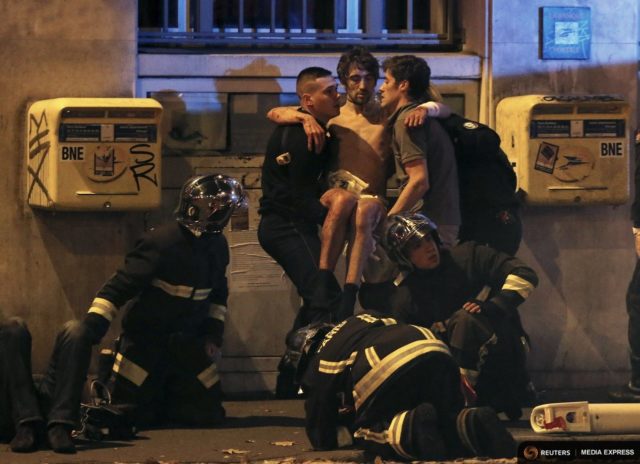
By Mark Young, SouthFloridaReporter.com Managing Editor, Nov. 18, 2015 – In a report released last night, The Institute for Economics and Peace, found that more than half of all terrorist attacks and deaths have been caused by just two groups; ISIL and Boko Haram. The cost in lives is over 32-thousand people, nearly double the number from 2013. The cost in dollars is almost $53-BILLION.
Here is a map of the GTI which measures the impact of terrorism in 162 countries. To account for the lasting effects of terrorism, each country is given a score that represents a five year weighted average. MAP
The information in this study is an eye-opener:
- 32,658 people were killed by terrorism in 2014 compared to 18,111 in 2013: the largest increase ever recorded
- Boko Haram and ISIL were jointly responsible for 51% of all claimed global fatalities in 2014
- Boko Haram has overtaken ISIL as world’s deadliest terrorist group
- Countries suffering over 500 deaths increased by 120% to 11 countries
- 78% of all deaths and 57% of all attacks occurred in just five countries: Afghanistan, Iraq, Nigeria, Pakistan and Syria
- Iraq continues to be the country most impacted by terrorism with 9,929 terrorist fatalities the highest ever recorded in a single country
- Nigeria experienced the largest increase in terrorist activity with 7,512 deaths in 2014, an increase of over 300% since 2013
The number of lives lost to terrorism increased by 80% in 2014, reaching the highest level ever recorded at 32,658. This compares to 18,111 in 2013. According to the third edition of the Global Terrorism Index (GTI), out today, this increase represents the largest yearly increase in deaths ever recorded. The report also highlights the dramatic rise in terrorism over time, with deaths increasing by nine-fold since the year 2000.
The report, developed by the Institute for Economics and Peace and based on data from the Global Terrorism Database of START, reveals that just two terrorist groups, ISIL and Boko Haram, are now jointly responsible for 51% of all global fatalities from claimed terrorist attacks. Boko Haram, which pledged its allegiance to ISIL as the Islamic State’s West Africa Province (ISWAP) in March 2015, has become the world’s deadliest terrorist group, causing 6,644 deaths compared to ISIL’s 6,073.
Terrorism is also highly concentrated: just five countries – Afghanistan, Iraq, Nigeria, Pakistan and Syria – accounted for 78% of all deaths in 2014. Iraq continues to be the country most impacted by terrorism, with 3,370 attacks killing 9,929 people. This is the highest number of terrorism incidents and fatalities ever recorded by a single country. Nigeria recorded the largest increase in deaths from terrorism, rising by over 300% to 7,512 fatalities.
However, terrorism spread significantly in the past year. The number of countries that suffered more than 500 deaths has more than doubled, increasing from five in 2013 to 11 in 2014. The new additions were Somalia, Ukraine, Yemen, Central African Republic, South Sudan and Cameroon.
The economic cost of terrorism reached its highest ever level in 2014 at US$52.9 billion, an increase of 61% from the previous year’s total of US$32.9 billion, and a tenfold increase since 2000.
Steve Killelea, Executive Chairman of IEP, said, “The significant increase in terrorist activity has meant that its ramifications are being felt more widely throughout the world. What is most striking from our analysis is how the drivers of terrorism differ between more and less developed countries. In the West, socio-economic factors such as youth unemployment and drug crime correlate with terrorism. In non-OECD countries, terrorism shows stronger associations with ongoing conflict, corruption and violence.
“Ten of the eleven countries most affected by terrorism also have the highest rates of refugees and internal displacement. This highlights the strong inter-connectedness between the current refugee crisis, terrorism and conflict.”
The flow of foreign fighters into Iraq and Syria since 2011 is the largest influx in modern times. Current estimates now range from 25,000 to 30,000 fighters, from roughly 100 countries. Half of the foreign fighters travelling to Iraq and Syria are from neighbouring MENA countries and a quarter from Europe and Turkey. The flow of foreign fighters does not appear to be diminishing, with over 7,000 arriving in the first six months of 2015.
Statistical analysis of the patterns of terrorist activity since 1989 found that there were two factors most closely associated with terrorism. These are the levels of political violence committed by the state, and the level of armed conflict within a country. The report finds that 92% of all terrorist attacks between 1989 and 2014 occurred in countries where political violence by the government was widespread, while 88% of all terrorist attacks between 1989 and 2014 occurred in countries that were experiencing or involved in violent conflicts.
Steve Killelea commented, “Since we can see a number of clearly identifiable socio-political factors that foster terrorism, it is important to implement policies that aim to address these associated causes. This includes reducing state-sponsored violence, diffusing group grievances, and improving respect for human rights and religious freedoms, while considering cultural nuances.”
Lone wolf attackers are the main perpetrators of terrorist activity in the West, causing 70% of all deaths over the past 10 years. Islamic fundamentalism is not the main driver of terrorism in Western countries: 80% of lone wolf deaths are by political extremists, nationalists, racial and religious supremacists.
While many countries experience no terrorist activity, the number of countries to experience at least one or more deaths from terrorist activity has increased from 59 in 2013 to 67 in 2014. This includes OECD countries such as Austria, Australia, Belgium, Canada and France.
Importantly, over 60% of the countries in the report experienced no deaths from terrorism. Since 2000, less than 3% of terrorist deaths occurred in the West. Thirteen times as many people are killed globally by homicides than die in terrorist attacks.
SOURCE Institute for Economics & Peace (IEP)












